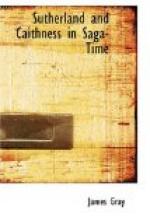In Hugo, the elder son of William son of Freskyn, we are deeply interested. For, if his father “William son of Freskyn” had no grant of Sutherland, Hugo Freskyn certainly had not only such a grant but possession as well. Two Charters, the Carta de Suthirland and Alia Carta Suthirlandiae appear in the list of documents in the Treasury of Edinburgh in 1282, and one or both of these may have been the original grant or grants of his Sutherland estate.[15] They may, on the other hand, have been the later grants of the earldom, or still later charters relating to it. They have, however, disappeared.
Notwithstanding their disappearance, ample evidence of the tenure of the estate of Sutherland by Hugo Freskyn has been preserved until the present day in the Charter-room at Dunrobin; and the documents are happily as legible as they were over 700 years ago.
By a charter,[16] dated about 1211, Hugo granted to Master Gilbert, Archdeacon of Moray and to those heirs of his family whom he should choose and their heirs, all his land of Skelbo in Sutherland and of Fernebuchlyn and Inner-Schyn, and also his whole land of Sutherland towards the west which lay between the aforenamed land and the marches of Ross, to be held to himself and to his own heirs for ever from the granter and his heirs, performing for such lands the service of one bowman and the forinsec service due to the king in respect of such lands; and this grant was confirmed by King William the Lion (who died in December 1214) on the 29th of April, probably in 1212, at Seleschirche, now Selkirk, and was also confirmed by Hugo’s son William, Lord of Sutherland, about 1214.[17] This renders it certain that Hugo himself had died before December 1214, the latest possible limit of the date of this charter. He was buried in the Church of Duffus, as the Register of Moray states,[18] and he can hardly have been the Hugo who witnessed the Charter of the Church of Lohworuora sixty-two years at least before, to which Prince Henry, who died in 1152, was a witness.[19] For Hugo of Sutherland would then have been too young to have been selected as a witness, and he was not Hugo, son of Freskyn (Hug. filio Fresechin), but Freskyn’s grandson.
Hugo Freskyn of Sutherland had three sons, (1) William, great-grandson of the original Freskyn, dominus or Lord of Sutherland, and afterwards first earl, (2) Walter, who succeeded to Strabrock in Linlithgowshire and to Duffus and the family estates in Moray, which were thus severed in ownership from Sutherland, and (3) Andrew. Walter of Duffus married Euphamia, daughter of the most able and renowned general of his time, Ferchar Mac-in-Tagart, Earl of Ross;[20] and Walter was known as Sir Walter de Moravia, and lived till 1243, but was dead by 1248, his widow surviving him, and later on we shall come to another Freskin, their eldest son, (who was dominus de Duffus on 20th March 1248), in Strathnaver and Caithness. Hugo’s third son, Andrew, was the parson of Duffus[21] who became Bishop of Moray, and moved the see from Spynie to Elgin, where he erected a specially beautiful Cathedral, the predecessor of that whose splendid ruins still stand. According to the Chronicle of Melrose he died in 1242.




